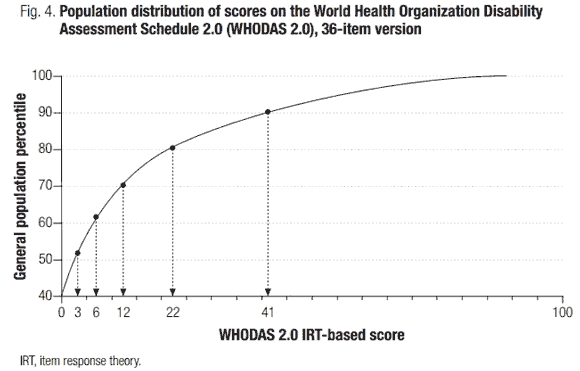世界卫生组织《残疾评定量表》的制订和测试
姚贵忠 舒良 沈渔邨 北京大学精神卫生研究所 100083
目的:与WHO协作开发一套国际通用的残疾评定工具——WHO残疾评定量表(Disability Assessment Schedule,DAS),测试其在中国应用的信度、效度,初步探讨评残分界值。
方法:
1.与WHO共同制订和测试DAS条目库,并通过多种问卷向残疾者及其家属、专业人员和政策制定者进行残疾状况调查,然后经过对DAS中介版本的测试,制订出DAS最终版本。
2.以中国精神残疾评定标准(SDSS-R)作为效标,2名评定者对254例受试者进行了DAS测试,测试评定者信度20例,测试重测信度100例。
3.纳入50名急性发作期精神分裂症患者,经过8周常规治疗,评定治疗前后DAS对病情变化的敏感性(STC)。
结果: DAS总分及6个因子分的重测相关系数都在0.9以上,评定者信度(ICC via ANOVA)为0.997,6个因子分之间以及每个因子分与总分之间的相关都具有高度显著性(P值均小于0.01)。因子分析的结果与原量表结构基本相符,各因子贡献率的分布与量表的理论构想是相一致的。DAS与SDSS-R、BPRS、CGI之间的相关都具有高度显著性(P值均小于0.01),提示DAS与三者之间的平行效度良好。经过8周临床治疗,随着BPRS和CGI得分的显著下降,DAS及其5个因子分的下降亦有显著性。本研究以SDSS-R的评分结果为基础,初步设定DAS的评残分界值为:51分以下无残疾,52-94分轻度,95-115分中度,116分以上重度,两种评残方法具有高度一致性(Kappa=0.592, P<0.01)。
结论: DAS的各项信度、效度指标均达到心理测量学要求,可以作为一种新的残疾评定工具使用,它的开发对推动残疾问题的研究意义重大。
————————————
DSM-IV Axis V consisted of the Global Assessment of Functioning (GAF) scale, representingthe clinician's judgment of the individual's overall level of "functioning on a hypotheticalcontinuum of mental health-illness." It was recommended that the GAF bedropped from DSM-5 for several reasons, including its conceptual lack of clarity (i.e., includingsymptoms, suicide risk, and disabilities in its descriptors) and questionable psychometricsin routine practice. In order to provide a global measure of disability, the WHODisability Assessment Schedule (WHODAS) is included, for further study, in Action III ofDSM-5 (see the chapter "Assessment Measures"). The WHODAS is based on the InternationalClassification of Functioning, Disability and Health (ICF) for use across all of medicineand health care. The WHODAS (version 2.0), and a modification developed for children/adolescents and their parents by the Impairment and Disability Study Group were includedin the DSM-5 field trial.
————————————
World Health Organization Disability Assessment Schedule 2.0
世界卫生组织残疾评定量表
The adult self-administered version of the World Health Organization Disability AssessmentSchedule 2.0 (WHODAS 2.0) is a 36-item measure that assesses disability in adults age 18years and older. It assesses disability across six domains, including understanding andcommunicating, getting around, sel^care, getting along with people, life activities (i.e.,household, work, and/or school activities), and participation in society. If the adult individualis of impaired capacity and unable to complete the form (e.g., a patient with dementia),a knowledgeable informant may complete the proxy-administered version of themeasure, which is available at www.psychiatry.org/dsm5. Each item on the self-administeredversion of the WHODAS 2.0 asks the individual to rate how much difficulty he or she hashad in specific areas of functioning during the past 30 days.
WHODAS 2.0 Scoring Instructions Provided by WHO
WHODAS 2.0 summary scores. There are two basic options for computing the summaryscores for the WHODAS 2.0 36-item full version.
Simple: The scores assigned to each of the items—"none" (1), "mild" (2), "moderate" (3),"severe" (4), and "extreme" (5)—are summed. This method is referred to as simple scoringbecause the scores from each of the items are simply added up without recoding or collapsingof response categories; thus, there is no weighting of individual items. This approach ispractical to use as a hand-scoring approach, and may be the method of choice in busy clinicalsettings or in paper-and-pencil interview situations. As a result, the simple sum of thescores of the items across all domains constitutes a statistic that is sufficient to describe thedegree of functional limitations.
Complex: The more complex method of scoring is called "item-response-theory"(IRT)-based scoring. It takes into account multiple levels of difficulty for each WHODAS2.0 item. It takes the coding for each item response as "none," "mild," "moderate," "severe,"and "extreme" separately, and then uses a computer to determine the summaryscore by differentially weighting the items and the levels of severity. The computer programis available from the WHO Web site. The scoring has three steps:
• Step 1—Summing of recoded item scores within each domain.
• Step 2—Summing of all six domain scores.
• Step 3—Converting the summary score into a metric ranging from 0 to 100
(where 0=no disability; 100=full disability).WHODAS 2.0 domain scores. WHODAS 2.0 produces domain-specific scores for sixdifferent functioning domains: cognition, mobility, self-care, getting along, life activities(household and work/school), and participation.
WHODAS 2.0 population nomris. For the population norms for IRT-based scoring of theWHODAS 2.0 and for the population distribution of IRT-based scores for WHODAS 2.0,please seewww.who.int/classifications/icf/Pop_norms_distrib_IRT_scores.pdf.
Additional Scoring and interpretation Guidance forDSiVI-5 Users
The clinician is asked to review the individual's response on each item on the measureduring the clinical interview and to indicate the self-reported score for each item in the sectionprovided for "Clinician Use Only." However, if the clinician determines that the scoreon an item should be different based on the clinical interview and other information available, he or she may indicate a corrected score in the raw item score box. Based on findingsfrom the DSM-5 Field Trials in adult patient samples across six sites in the United Statesand one in Canada, DSM-5 recommends calculation and use of average scores for each domainand for general disability. The average scores are comparable to the WHODAS 5-point scale,which allows the clinician to think of the individual's disability in terms of none (1), mild(2), moderate (3), severe (4), or extreme (5). The average domain and general disabilityscores were found to be reliable, easy to use, and clinically useful to the clinicians in theDSM-5 Field Trials. The average domain score is calculated by dividing the raw domain scoreby the number of items in the domain (e.g., if all the items within the "understanding andcommunicating" domain are rated as being moderate then the average domain scorewould be 18/6=3, indicating moderate disability). The average general disability score is calculatedby dividing the raw overall score by number of items in the measure (i.e., 36). Theindividual should be encouraged to complete all of the items on the WHODAS 2.0. If no responseis given on 10 or more items of the measure (i.e., more than 25% of the 36 totalitems), calculation of the simple and average general disability scores may not be helpful.If 10 or more of the total items on the measure are missing but the items for some of the domainsare 75%-100% complete, the simple or average domain scores may be used for thosedomains.
Frequency of use. To track change in the individual's level of disability over time, themeasure may be completed at regular intervals as clinically indicated, depending on thestabihty of the individual's symptoms and treatment status. Consistently high scores on aparticular domain may indicate significant and problematic areas for the individual thatmight warrant further assessment and intervention.

——————————————
DSM5 中的WHDAS2.036项目版本, 由受检者自评健康状况是指短期存在或是长久持续的疾病或其他健康问题;损伤;精神或情绪问题;以及饮酒及吸毒问题。
请您回顾最近30天的情况,然后回答以下问题,考虑一下在进行下述活动时有多大的困难。对于每一问题,请圈选唯一最佳选项。
认知
D1.1集中注意力做事情超过10分钟?
D1.2记得去做重要的事?
D1.3分析并解决日常生活中遇到的问题?
D1.4学习一项新任务, 比如学习怎么去一个新地方?
D1.5大致理解别人的言语?
D1.6发起并维持一次谈话?
活动性
D2.1长时间站立(如30分钟)?
D2.2坐下后站起?
D2.3在家中来回走动?
D2.4从家中外出?
D2.5长距离行走(如一公里或相似距离)?
自理
D3.1自己洗澡
D3.2穿好衣服
D3.3进食?
D3.4独立生活数日?
与他人相处
D4.1与陌生人相处?
D4.2维持一段友情?
D4.3同与你关系密切的人相处?
D4.4结交新朋友?
D4.5性活动?
家务活动
D5.1承担家庭责任?
D5.2很好地完成您最重要的家务劳动?
D5.3干完您需要做的所有家务劳动?
D5.4按照需要,尽快完成家务劳动?
与工作或学习相关的各项活动
D5.5您的日常工作/学习?
D5.6很好的完成大多数重要的工作或学习?
D5.7完成您份内的所有工作?
D5.8尽可能快的完成工作?
社会参与
D6.1您在像他人一样参与社区活动(例如庆祝节日,宗教活动或其他)时,存在多大困难?
D6.2您周围环境的阻碍和限制,使您产生多大困难?
D6.3他人的行为及态度,给您“有尊严的活着”带来了多大的困难?
D6.4您在健康问题或其影响方面,花费了多少时间?
D6.5健康问题对您情绪的影响有多严重?
D6.6您的健康问题给您或您的家庭带来多大的的经济损失?
D6.7因为您的健康问题,您的家庭遇到多大困难?
D6.8在自我放松或娱乐活动方面,您有多大困难?
——————————————
微盘下载:http://vdisk.weibo.com/s/ud51QbvL-n9_/1402728421
WHO:http://www.who.int/classifications/icf/whodasii/en/
www.psychspace.com心理学空间网
